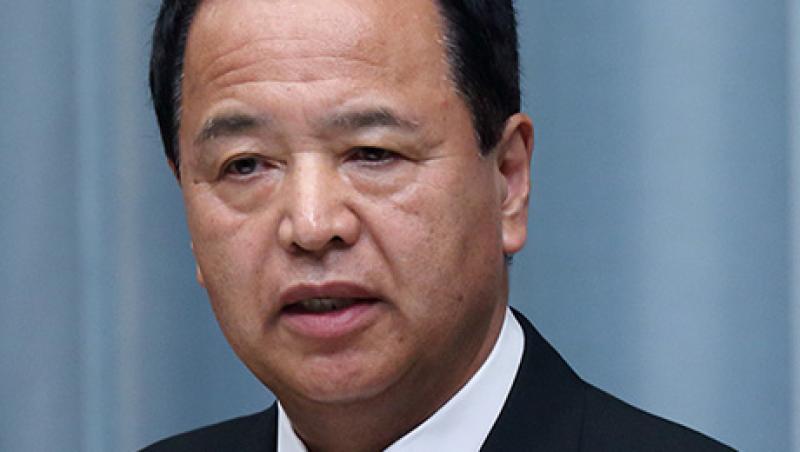Prime Minister Shinzo Abe’s key economic adviser acknowledges worries about the recent sharp slowdown in Japan’s economy, but he insists that Abenomics is working and says the government will take additional measures, if needed, to keep growth on track.
“Yes, I know there are concerns shown from the various analysts and experts about the growth strategy,” Akira Amari, minister in charge of Economic Revitalization, tells Institutional Investor in an exclusive interview. Officials have plenty of tools at their disposal to revitalize the economy, though, he adds.
“We have a key performance indicator, or KPI, system that examines if policy implementation of the growth strategy is going properly or not,” says Amari, speaking in his office, which sits just across the street from the prime minister’s residence in central Tokyo. “Rest assured I will make additional policy adjustments, if necessary, by proper analysis based on the economic data. I am quite willing to implement additional measures when needed to make sure we are on track to meeting our targets. Therefore I am confident that we can overcome the challenges and address the concerns of the public and the outside world.”
Concerns about Abenomics, as the prime minister’s policies are known, rose after Japan’s gross domestic product shrank at a 7.1 percent rate in the quarter ended June 30 — the biggest contraction since the aftermath of the country’s 2011 earthquake and tsunami. The dip in economic activity was largely caused by a sharp hike in the consumption tax, from 5 percent to 8 percent, in April. Abe and his team raised the consumption tax to help contain Japan’s budget deficit and debt and pay for rising social welfare costs stemming from the country’s aging population. Japan has one of the lowest birth rates in the world and the highest ratio of elderly to young people, raising serious concerns about future economic growth.
Amari, 65, who previously served as Japan’s minister of Economy, Trade and Industry from 2006 to 2008, did not make clear whether he would advise the prime minister on delaying the hike, which is scheduled to take effect in October 2015. But he says both he and the prime minister remain convinced that their policies will work in the long run. The fact that Japan’s economy has grown and inflation has turned positive since Abe took office in December 2012 is already proof that Japan has ended nearly 20 years of deflation and stagnation, he contends.
Miyuki Kashima, head of Japan equities at BNY Mellon Asset Management, agrees, noting that Japan’s nominal GDP has registered positive year-on-year growth every quarter since the second quarter of 2013. “Nominal GDP grew 1.9 percent in the fiscal year ending March 2014,” she says. “That is the highest level in over 15 years.”
Financial markets have reacted strongly so far to the so-called three arrows of Abenomics — monetary easing, fiscal stimulus and structural reform. By ramping up its program of quantitative easing and doubling the monetary base, the Bank of Japan has fostered a sharp drop in the yen, to around 108 to the dollar, its lowest level in six years. That depreciation has helped put inflation into positive territory and given Japanese exporters a boost. Stock prices have rallied strongly, meanwhile, with the Tokyo Stock Exchange’s TOPIX index rising 54.7 percent since Abe took office.
Less conventional indicators also indicate that the government’s policies are having an impact, Amari says. He notes that the number of visitors to Japan increased by 24 percent from 2012 to 2013 and is expected to increase by a further 20 percent this year.
Top-level government involvement in export promotion has helped Japanese companies triple the amount of infrastructure projects taken on, from 3 trillion yen in 2012 to 9 trillion yen in 2013, he says. The government is working with the nation’s major contractors to win bids for foreign infrastructure projects, with the goal of achieving 30 trillion yen worth of orders annually by 2020. In the past 18 months, Abe, Amari and other officials on their overseas trips have cooperated with major Japanese construction companies to make 67 infrastructure pitches to the governments of foreign trade partners.
In addition, Amari notes that Abe pushed through the parliament a revision of the Companies Act that promotes the appointment of external directors. Largely as a result, the share of corporate board seats held by independent external directors rose to 61 percent at major listed companies in 2014 from 47 percent in 2013.
Amari and other ministers are reviewing Japan’s corporate tax regime with the aim of reducing the tax rate from 38 percent currently to the mid–20 percent range in the coming few years. The government will make an initial reduction of yet-to-be-announced size as early as the next fiscal year, he says.
Amari says his primary job is enforcing a cabinetwide goal of reaching targets on 117 key performance indicators under Abenomics.
For instance, the government has set a target of increasing the number of foreign tourists to more than 30 million by 2030, up from 10.36 million in 2013. To that end, the government is looking at relaxing visa restrictions to such countries as Indonesia, the Philippines and Vietnam.
The government plans to relax the rules for foreign investors with the aim of doubling the country’s stock of foreign direct investment to 35 trillion yen, up from 18 trillion yen in 2013, he says.
To help overcome a labor shortage in Japan, the government is taking a two-pronged approach: promoting women’s participation in the labor force to a target of 73 percent, up from the current 68 percent, and relaxing rules for foreign highly skilled workers to enter and legally work in Japan. Since the beginning 2013, more than 820,000 women have entered the workplace, Amari says. To make it easier for women to reenter the labor force, the government is cutting red tape and increasing public assistance for child care centers.
In addition to promoting women in the workplace, the administration is seeking to get more women into senior management positions. The Japan Revitalization Strategy, as the third arrow of structural reforms is formally called, has set a target of increasing the percentage of women managers from 6.9 percent to 30 percent by 2020.
To set an example for the corporate sector, Abe recently reshuffled his cabinet, raising the number of women in the 18-member group from two to five — matching a record held by the 2001 cabinet of former prime minister Junichiro Koizumi. Among the new women ministers is rising star Yuko Obuchi, 40, a former vice minister of Finance who was named minister of Economy, Trade and Industry.
“We are promoting the hiring and further use of women or foreigners who have skills and abilities that Japan needs,” Amari says. “In other words, we are focusing on reforms that lead to raising the overall productivity of the supply side.”
All of these performance targets are focused on economic revitalization, Amari says. “For the past 20 years, Japan could not get out a deflationary cycle,” he says. “The greatest aim is to get rid of this long deflationary cycle and to get the Japanese economy on the path to stable growth again. It is the biggest agenda for us: to help the economy achieve 3 percent nominal growth annually and 2 percent in real terms. We believe we have the measures in place to achieve these goals.”
Follow Allen Cheng on Twitter at @acheng87.





